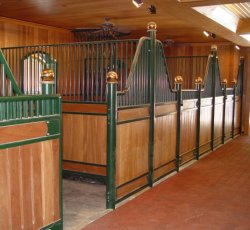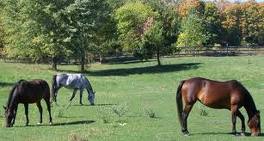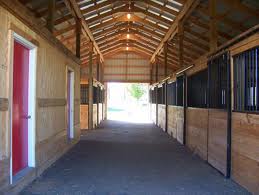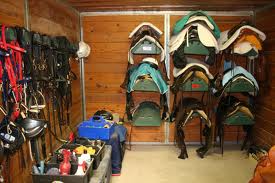|
The Cost of HorsekeepingInspite of the cost of horsekeeping, horse ownership continues to increase in popularity. While horses are still used for some agriculture enterprises, most horses are used for pleasure riding, breeding or competition such as showing or racing. The horse has played an important part in America’s heritage. The horse continues to play an integral part in providing a recreational outlet and creating income for individuals interested in professional employment with horses. Most horse owners will testify that their passion and love for the horse is why they are part of this ever-expanding industry.

Horsekeeping Facilities Where can I keep my horse? Horses can be kept at home for convenience. Space is certainly an important problem when considering the cost of horsekeeping at home. Is there enough room, are there zoning restrictions, or is there access to riding areas. Some people have made significant changes in their lifestyles in order to keep horses. Some have moved to the suburbs or the country because zoning in urban areas prohibits horsekeeping. Under these circumstances, the cost of horsekeeping involved in owning a horse has little to do with the horse itself. Traveling to and from town, expenses for additional acreage, and the possibility of higher utility rates are all new expenses. Commercial stables provide a whole range of horsekeeping services, in addition to providing a place to keep horses. Expect to pay more if the stable offers more. Indoor arenas, groomed riding rings, wash racks, trails, jumps, larger stalls, new barns, automatic waters or feeders will all be reflected in the cost of horsekeeping board.
Self Care Board With self care board, expect to supply everything your horse needs but the shelter and fencing. Water should be available but you might have to provide a trough or buckets. You'll have to purchase and bring in your own feed, including hay and bedding for stalls. Horses may or may not be checked every day, depending on the agreement you sign. Expect to travel at least once a day to care for your horse and clean stalls. You will have to arrange for veterinarian and farrier calls.

Pasture Board Pasture board can be very economical horsekeeping. Your horse will live outdoors all year round with feed, water and a run-in shelter. If your horse needs blanketing in cold weather you may pay extra for the owner/manager to take the blanket on or off depending on the weather.
Exercise Your horse should receive daily exercise. If your horse is kept in a stall, it is important for you to exercise it daily. However, if you have enough space for a large paddock or pasture, your horse can exercise on its own.
Hoof Care Your horse will require routine hoof care. Your horse should receive hoof care about every two months. Depending upon many circumstances, this time frame can be reduce to 3 to 4 week intervals. A farrier will usually perform your hoof care services and can advise you on specific needs your horse may have. Your horse may require specialized shoeing, if your horse has navicular, has foundered, or is recovering from hoof neglect, his shoeing bill will be higher.
Costs of Horse Ownership There are certain minimum investments and operating costs involved in horsekeeping. You should realistically try to estimate all costs. Feeding, general and health care, and some other costs can be calculated into your horsekeeping budget. Depreciation on facilities and equipment should be figured, as well as interest on the investment and operating cost.
It appears that you can keep a horse for $6.04 a day or about $2426.62 a year. Remember, this estimate included keeping your horse at home, figuring minimum values and making no charge for your labor. These values can changed based on whether you have pasture to offset your hay cost or you rent pasture. Remember these costs of horsekeeping are estimates and will vary for different parts of the country and will change over time.
Return from Cost of horsekeeping to Horse Riding Connection
|
 Full Board
The cost of horsekeeping with full board equates to everything being supplied. Stalls will be cleaned, the horse will be fed and watered and basic feeds supplied. Supplements may or may not be supplied but will be fed if you supply them. Horses will be turned out for exercise daily and blanketed (usually an extra cost)according to the weather. Veterinarians and farriers will be arranged by the owner/manager. Lessons may be included in the cost. Your boarding contract should outline all services provided and what you will have to pay extra for. How much of the horsekeeping labor you do yourself, even if you board, if you clean your horse's stall and pen, it will likely lower your board bill.
The cost of horsekeeping can vary tremendously from $35.00/day to up $1000.00/month or more depending on how much you want to provide as the owner. These estimates show that horsekeeping can be costly. Costs depend greatly upon facilities available and the amount of time and effort you are willing or able to provide.
Full Board
The cost of horsekeeping with full board equates to everything being supplied. Stalls will be cleaned, the horse will be fed and watered and basic feeds supplied. Supplements may or may not be supplied but will be fed if you supply them. Horses will be turned out for exercise daily and blanketed (usually an extra cost)according to the weather. Veterinarians and farriers will be arranged by the owner/manager. Lessons may be included in the cost. Your boarding contract should outline all services provided and what you will have to pay extra for. How much of the horsekeeping labor you do yourself, even if you board, if you clean your horse's stall and pen, it will likely lower your board bill.
The cost of horsekeeping can vary tremendously from $35.00/day to up $1000.00/month or more depending on how much you want to provide as the owner. These estimates show that horsekeeping can be costly. Costs depend greatly upon facilities available and the amount of time and effort you are willing or able to provide.

